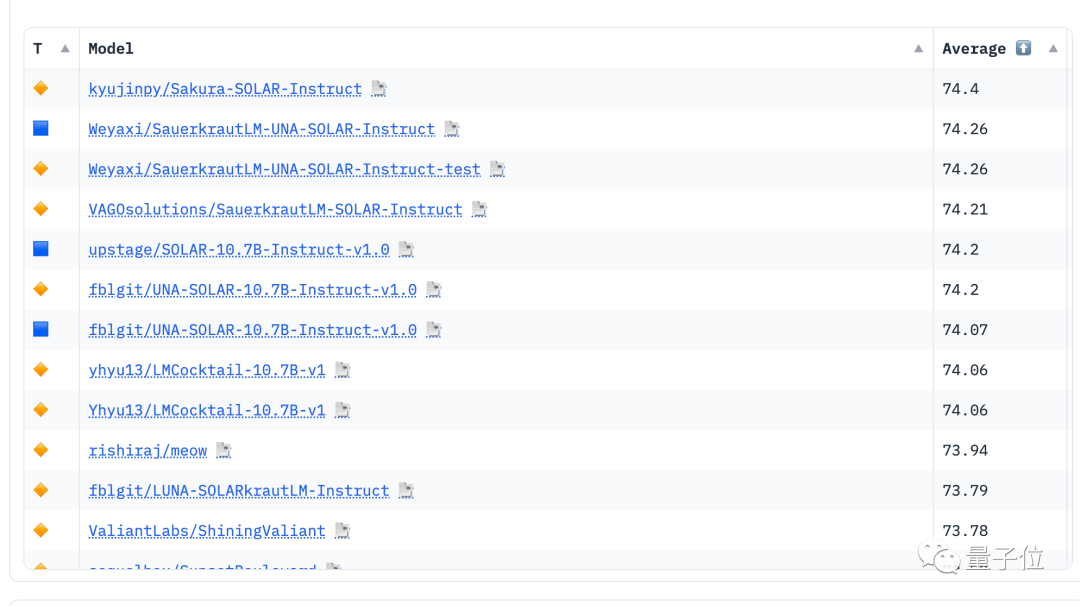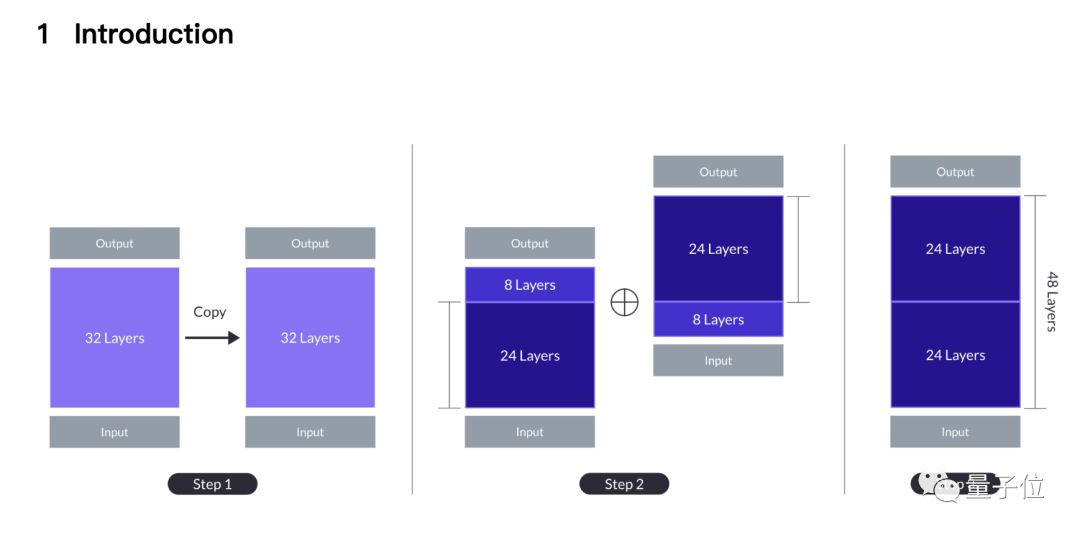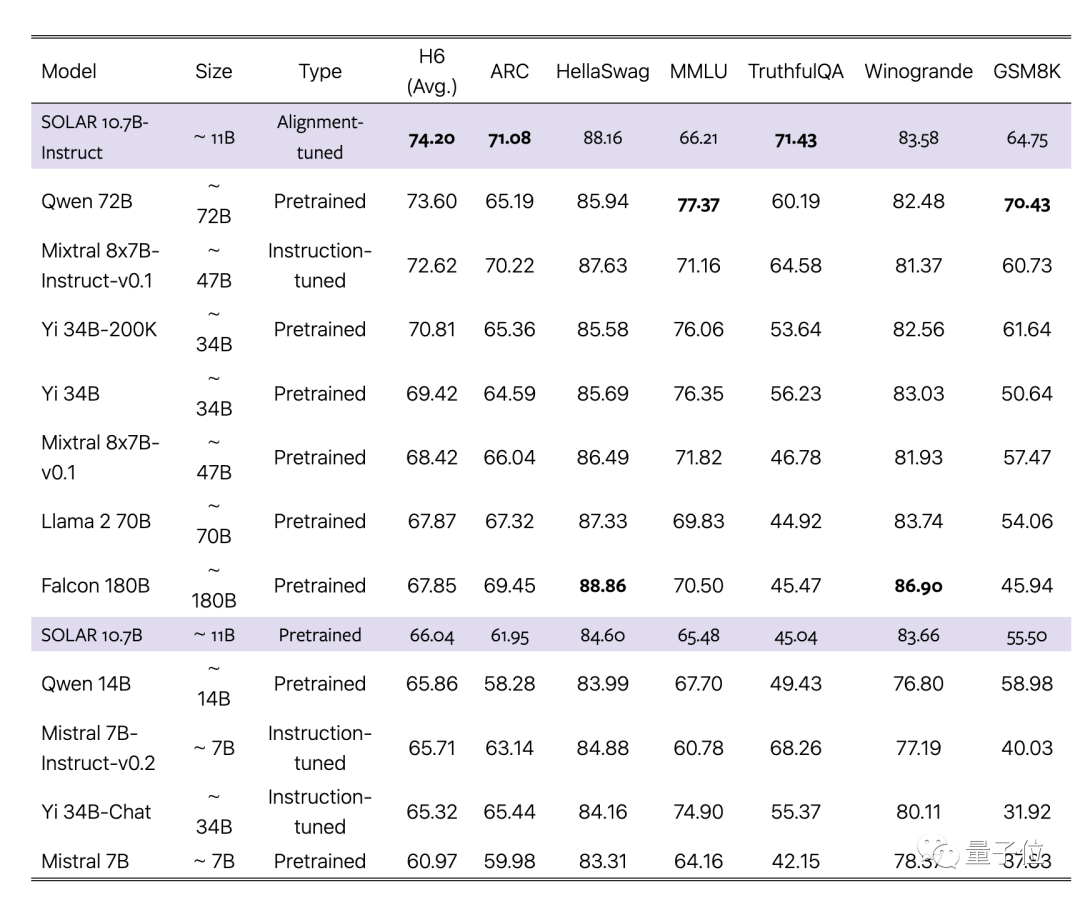 Technology peripherals
Technology peripherals
 AI
AI
 HuggingFace: Two alpacas are spliced together after removing their heads and tails
HuggingFace: Two alpacas are spliced together after removing their heads and tails
HuggingFace: Two alpacas are spliced together after removing their heads and tails
HuggingFace’s open source large model rankings have been eliminated again.
The front row is exclusively occupied by the SOLAR 10.7B fine-tuned version, squeezing out the various Mixtral 8x7B fine-tuned versions from a few weeks ago.

#What is the origin of the large SOLAR model?
The related paper has just been uploaded to ArXiv, from the Korean company Upstage AI, using the new large model expansion method depth up-scaling(DUS).

To put it simply, it’sTwo 7B alpacas cut off the head and tail, one cut off the first 8 layers, and the other Only cut off the last 8 layers.
The remaining two 24 layers are stitched together, the 24th layer of the first model is spliced with the 9th layer of the second model, and finally becomes New 48-story 10.7B large model.

The paper claims that the new method surpasses traditional extension methods such as MoE, and can use exactly the same infrastructure as the basic large model.
There is no need for additional modules such as gated networks, the training framework is optimized for MoE, and there is no need to customize CUDA kernels for fast inference. It can be seamlessly integrated into existing methods while maintaining efficiency.
The team chose Mistral 7B, the strongest single large model of 7B, as the base material, and used new methods to splice it together to surpass the original version and the MoE version.
At the same time, the aligned Instruct version also surpasses the corresponding MoE Instruct version.

Carry out the stitching to the end
Why is this splicing method? The introduction in the paper comes from an intuition.
Start with the simplest expansion method, which is to repeat the 32-layer basic large model twice to become 64 layers.
The advantage of this is that there is no heterogeneity, all layers are from the base large model, but the seams of layer 32 and layer 33 (same as layer 1) There is a larger "layer distance"(layer distance).
Previous research has shown that different layers of Transformer do different things. For example, deeper layers are better at processing more abstract concepts.
The team believes that too large a layer distance may hinder the model's ability to effectively utilize pre-trained weights.
One potential solution was to sacrifice the middle layer, thereby reducing the difference at the seams, and this is where the DUS method was born.
Based on the trade-off between performance and model size, the team chose to delete 8 layers from each model, and the seams were changed from 32 layers to layer 1 to 24 layers to layer 9.
The performance of the simply spliced model will still be lower than the original base model at first, but it can recover quickly after continued pre-training.
In the instruction fine-tuning phase, in addition to using open source data sets, a mathematically enhanced data set was also produced, and DPO was used in the alignment phase.
The last step is to weight the average of the model versions trained using different data sets, which is also the completion of the stitching.

Some netizens questioned the possibility of test data leakage.

The team also took this into consideration and specifically reported the data pollution test results in the appendix of the paper, which showed a low level.

Finally, both the SOLAR 10.7B basic model and the fine-tuned model are open source under the Apache 2.0 license.
Netizens who have tried it have reported that it performs well in extracting data from JSON format data.

Paper address: https://arxiv.org/abs/2312.15166
The above is the detailed content of HuggingFace: Two alpacas are spliced together after removing their heads and tails. For more information, please follow other related articles on the PHP Chinese website!

Hot AI Tools

Undresser.AI Undress
AI-powered app for creating realistic nude photos

AI Clothes Remover
Online AI tool for removing clothes from photos.

Undress AI Tool
Undress images for free

Clothoff.io
AI clothes remover

Video Face Swap
Swap faces in any video effortlessly with our completely free AI face swap tool!

Hot Article

Hot Tools

Notepad++7.3.1
Easy-to-use and free code editor

SublimeText3 Chinese version
Chinese version, very easy to use

Zend Studio 13.0.1
Powerful PHP integrated development environment

Dreamweaver CS6
Visual web development tools

SublimeText3 Mac version
God-level code editing software (SublimeText3)

Hot Topics
 What are the next thousand-fold coins in 2025?
Apr 24, 2025 pm 01:45 PM
What are the next thousand-fold coins in 2025?
Apr 24, 2025 pm 01:45 PM
As of April 2025, seven cryptocurrency projects are considered to have significant growth potential: 1. Filecoin (FIL) achieves rapid development through distributed storage networks; 2. Aptos (APT) attracts DApp developers with high-performance Layer 1 public chains; 3. Polygon (MATIC) improves Ethereum network performance; 4. Chainlink (LINK) serves as a decentralized oracle network to meet smart contract needs; 5. Avalanche (AVAX) trades quickly and
 What are the top ten virtual currency trading apps? The latest digital currency exchange rankings
Apr 28, 2025 pm 08:03 PM
What are the top ten virtual currency trading apps? The latest digital currency exchange rankings
Apr 28, 2025 pm 08:03 PM
The top ten digital currency exchanges such as Binance, OKX, gate.io have improved their systems, efficient diversified transactions and strict security measures.
 Bitcoin price today
Apr 28, 2025 pm 07:39 PM
Bitcoin price today
Apr 28, 2025 pm 07:39 PM
Bitcoin’s price fluctuations today are affected by many factors such as macroeconomics, policies, and market sentiment. Investors need to pay attention to technical and fundamental analysis to make informed decisions.
 Which of the top ten currency trading platforms in the world are the latest version of the top ten currency trading platforms
Apr 28, 2025 pm 08:09 PM
Which of the top ten currency trading platforms in the world are the latest version of the top ten currency trading platforms
Apr 28, 2025 pm 08:09 PM
The top ten cryptocurrency trading platforms in the world include Binance, OKX, Gate.io, Coinbase, Kraken, Huobi Global, Bitfinex, Bittrex, KuCoin and Poloniex, all of which provide a variety of trading methods and powerful security measures.
 Ranking of the most promising virtual currency in 2025
Apr 24, 2025 pm 01:27 PM
Ranking of the most promising virtual currency in 2025
Apr 24, 2025 pm 01:27 PM
The most development potential of virtual currencies in 2025 include: 1. Ethereum (ETH), due to its leadership in smart contracts and DeFi; 2. Bitcoin (BTC), due to its status as a store of value and its recognition as an institutional investor; 3. Solana (SOL), due to its high throughput and low transaction fees; 4. Cardano (ADA), due to its technological strength and ecosystem improvement; 5. Polkadot (DOT), due to its cross-chain interoperability; 6. Avalanche (AVAX), due to its potential in the DeFi field; 7. Chainlink (LINK), due to its critical role in DeFi; 8. Cosmos (ATOM), due to its
 Recommended reliable digital currency trading platforms. Top 10 digital currency exchanges in the world. 2025
Apr 28, 2025 pm 04:30 PM
Recommended reliable digital currency trading platforms. Top 10 digital currency exchanges in the world. 2025
Apr 28, 2025 pm 04:30 PM
Recommended reliable digital currency trading platforms: 1. OKX, 2. Binance, 3. Coinbase, 4. Kraken, 5. Huobi, 6. KuCoin, 7. Bitfinex, 8. Gemini, 9. Bitstamp, 10. Poloniex, these platforms are known for their security, user experience and diverse functions, suitable for users at different levels of digital currency transactions
 How much is Bitcoin worth
Apr 28, 2025 pm 07:42 PM
How much is Bitcoin worth
Apr 28, 2025 pm 07:42 PM
Bitcoin’s price ranges from $20,000 to $30,000. 1. Bitcoin’s price has fluctuated dramatically since 2009, reaching nearly $20,000 in 2017 and nearly $60,000 in 2021. 2. Prices are affected by factors such as market demand, supply, and macroeconomic environment. 3. Get real-time prices through exchanges, mobile apps and websites. 4. Bitcoin price is highly volatile, driven by market sentiment and external factors. 5. It has a certain relationship with traditional financial markets and is affected by global stock markets, the strength of the US dollar, etc. 6. The long-term trend is bullish, but risks need to be assessed with caution.
 Which of the top ten currency trading platforms in the world are among the top ten currency trading platforms in 2025
Apr 28, 2025 pm 08:12 PM
Which of the top ten currency trading platforms in the world are among the top ten currency trading platforms in 2025
Apr 28, 2025 pm 08:12 PM
The top ten cryptocurrency exchanges in the world in 2025 include Binance, OKX, Gate.io, Coinbase, Kraken, Huobi, Bitfinex, KuCoin, Bittrex and Poloniex, all of which are known for their high trading volume and security.





